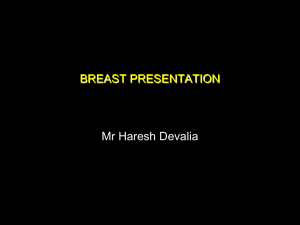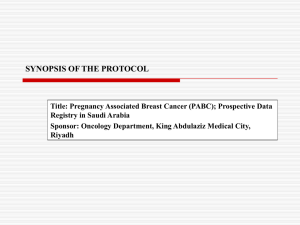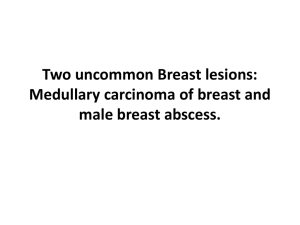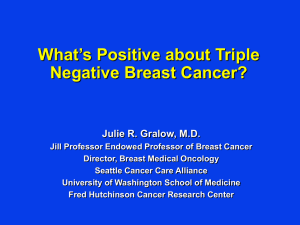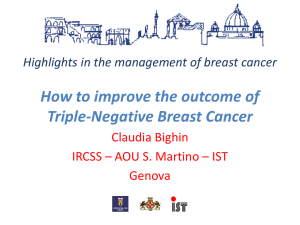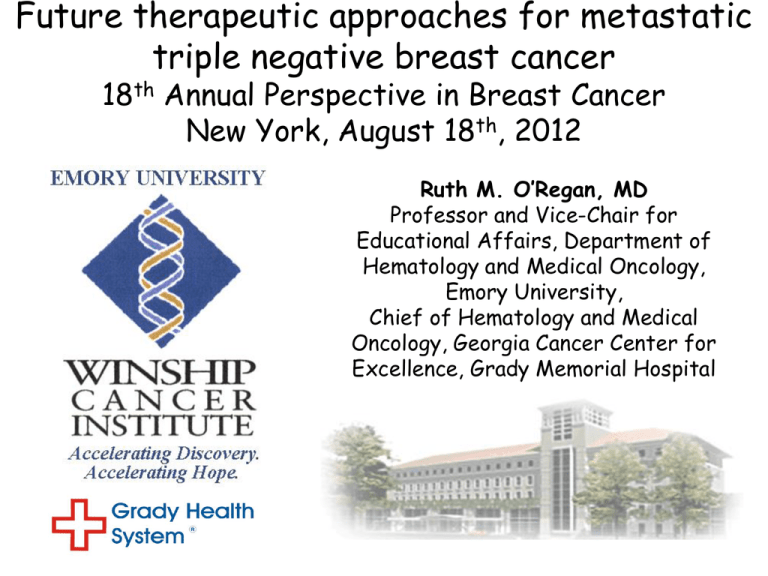
Future therapeutic approaches for metastatic
triple negative breast cancer
18th Annual Perspective in Breast Cancer
New York, August 18th, 2012
Ruth M. O’Regan, MD
Professor and Vice-Chair for
Educational Affairs, Department of
Hematology and Medical Oncology,
Emory University,
Chief of Hematology and Medical
Oncology, Georgia Cancer Center for
Excellence, Grady Memorial Hospital
Triple negative breast cancers have a high recurrence rate
following initial diagnosis with a poor survival
Basal/TN
Basal/TN
Copyright ©2003 by the National Academy of Sciences
Sorlie et al PNAS 2003
Triple negative breast cancers
High grade aggressive cancers with a
high propensity to distant metastases in
short-term
Poor outcome is associated with
Chemo-resistance (only about one-third
respond to chemotherapy)
Lack of molecular targets towards which
novel agents can be developed
Triple Negative Tumors
(%) By Age
60
50
%
40
30
56.6
55.4
42.2
42.2
44.2
28.6
20
10
0
41.2
17.3
20-34
35-39
40-44
Black
19.6
45-49
19.5
50-54
White
Lund Breast Cancer Res Treat 2008
Topics to be covered
Triple negative breast cancers
represent a heterogeneous group of
cancers which likely require different
therapeutic approaches
Potential therapeutic targets
Chemo-resistance – how can we manage
patients with early stage breast cancer
who have resistant cancers
Iniparib does not improve outcome in unselected
metastatic triple negative breast cancer
GC
(N=258)
PFS
Median PFS, mos
(95% CI)
HR (95% CI)
p-value
0.9
OS
4.1
5.1
(3.1, 4.6)
(4.2, 5.8)
0.79 (0.65, 0.98)
0.027
0.9
Pre-specified alpha = 0.01
0.8
GC
GCI
(N=258) (N=261)
11.1
11.8
(9.2, 12.1) (10.6, 12.9)
0.88 (0.69, 1.12)
0.28
Pre-specified alpha = 0.04
0.8
0.7
0.6
0.5
0.4
0.3
0.7
0.6
0.5
0.4
0.3
0.2
0.2
0.1
0.1
0
Median OS, mos
(95% CI)
HR (95% CI)
p-value
1.0
Probability of Survival
Probability of Progression Free Survival
1.0
GCI
(N=261)
0
2
4
6
8
10
12
14
Months Since Study Entry
No. at risk
0
16
0
2
4
6
8
10
12
14
16
Months
No. at risk
GC
258
171
116
63
38
18
6
1
0
GC
258
239
214
181
151
99
38
11
0
GCI
261
187
138
83
53
11
2
0
0
GCI
261
248
230
204
169
111
52
15
0
O’Shaughnessy PASCO 2011
Sub-types of triple negative
breast cancer
• Evaluated gene expression profiles from
21 breast cancer data sets (14 training
and 7 validation = 587 cases of TNBC)
• Used cluster analysis to sub-divide
TNBC into 6 sub-types displaying unique
gene expression and ontologies
• Identified breast cancer cells lines
representative of each subtype
Lehmann et al JCI 2011
Basal-like 1: cell cycle,
DNA repair and
proliferation genes
Basal-like 2: Growth factor
signaling (EGFR, MET, Wnt,
IGF1R)
IM: immune cell
processes (medullary
breast cancer)
M: Cell motility and
differentiation, EMT
processes
MSL: similar to M but
growth factor signaling, low
levels of proliferation genes
(metaplastic cancers)
Lehmann et al JCI 2011
LAR: Androgen receptor
and downstream genes,
luminal features
Cell lines correspond to the 6 triple negative subtypes
Lehmann et al JCI 2011
Sub-types demonstrate differential response to therapies in vivo
Vehicle
Cisplatin
Anti-androgen
P13K/mTOR
inhibitor
Lehmann et al JCI 2011
Is EGFR a viable target for triple negative
breast cancer?
EGFR/HER1
K-Ras
GRO1
TCF4
Frizzled 7
Laminin gamma 2
c-KIT
Keratin 5
Keratin 17
P-Cadherin
Randomized Phase II:
Cetuximab +/- Carboplatin for Triple-Negative MBC
R
A
N
D
O
M
I
Z
E
Cetuximab + Carboplatin at
Progression
N=22
Cetuximab
N=31
Cetuximab + Carboplatin
N=49
Arm 1
Cetuximab Cetuximab +
carboplatin
N
Arm 2
Cetuximab +
carboplatin
Arm 1b + 2
31
24
71
95
ORR
CR
PR
2 (6%)
0
2 (6%)
4 (17%)
0
4 (17%)
12 (17%)
1 (1%)
11 (15%)
16 (17%)
1 (1%)
15 (16%)
SD
5 (16%)
6 (25%)
16 (23%)
22 (23%)
Carey et al. J Clin Oncol 2012
EGFR inhibitors in TNBC
PD01-01
Met TNBC
≤ 1 chemo
for mets
Cisplatin + Cetuximab (n=114)
R
Cisplatin (n=57)
Cis + EGFR
Cis
p
Response (%)
20
10
0.5
PFS (mo)
3.7
1.5
0.032
Baselga et al SABCS 2010
Cell Survival Rate
mTOR inhibition sensitizes triple negative breast cancer
130%
cells to EGFR inhibition
120%
110%
100%
90%
80%
70%
60%
50%
40%
30%
20%
10%
0%
Rapamycin
Rapamycin
Lapatnib
Rapamycin+ Lapatnib
Erlotinib
Lapatinib
Rapa .78 1.56 nM 3.125 nM 6.25 nM12.50 nM25.0 nM 50.0 nM 100 nM
.3125 uM.625 uM 1.25 uM 2.50 uM 5.00 uM 10.0 uM 20.0 uM
Lapa
.156 uM
Concentration
Tumor volume (mm3)
300
200
150
100
+
+
+
+
+
+
p-EGFR
pMAPK
p-S6
p<0.0001
p=.01 -actin
MDA-MB-468
50
0
+
p-Akt
P
=
0
Control
.
Rapamycin
Lapatinib
0
Rapa+Lapa
0
0
1
250
Day 14
Day 17
Day 21
Day 24
Day 28
Liu et al Mol Cancer Ther 2011
Phase 2 trial of Lapatinib and Everolimus
in metastatic TN breast cancer
Metastatic TN
breast cancer
prior taxanes
and anthracyclines
Second/third-line
n = 40
TN in metastatic
setting
Lapatinib 1250mg daily
RAD001 5mg daily
BX
CT
Primary endpoint: response rate
CT
Incidence of pCR by Breast
Cancer Subtype
• 107 patients treated with neoadjuvant AC and
hormone therapy if HR+.
Response
Type
All
Patients
N=107
(%)
Basal Like
N=34
(%)
HER2
N=11
(%)
Luminal B
N=26
(%)
Luminal A
N=36
(%)
CR
14
29
10
8
6
PR
47
56
60
50
33
SD
38
15
30
42
58
PD
1
0
0
0
3
pCR
16
27
36
15
0
Carey et al; Clin Cancer Res 2007; 13(8)
Importance of Pathologic CR
Overall Survival
Liedtke et al. JCO 2008; 26(8): 1275-81
Among Basal-like Tumors
RCB I (n = 2)
RCB 0 (n = 16)
RCB II (n = 17)
RCB III (n= 9)
Log-rank P = 5.5 x 10-7
Chemo-resistance is a
significant issue with TNBC
• PCR is clearly a very robust prognostic
factor for outcome in TNBC
• How can we increase PCR rate?
• How should we manage patients with
residual cancer following pre-operative
chemotherapy?
Neoadjuvant Chemo plus Carboplatin +/Bevacizumab in Stage II-III TNBC
(Phase II CALBG 40603)
Paclitaxel 80mg/m2 wkly x4
ddAC x4
Paclitaxel 80mg/m2 wkly x4
ddAC x4
Bevacizumab 10mg/kg q2w x 9
Paclitaxel 80mg/m2 wkly x4
4-8 wks after last
ddAC
ddAC x4
Carboplatin AUC 6 q3w x 4
Paclitaxel 80mg/m2 wkly x4
Surgery
ddAC x4
XRT
No adjuvant chemo
planned
Bevacizumab 10mg/kg q2w x 9
Carboplatin AUC 6 q3w x 4
Sikov WM, et al. J Clin Oncol. 2010;28:15s (Abstract TPS 110).
Phase II Neoadjuvant Trial of Sorafenib in
combination with Cisplatin followed by dose
dense Paclitaxel for ER-, PR-, HER2- (Triple
Negative) Early-stage Breast Cancer
PET
Biopsy
PET
Biopsy
Early Stage
Triple Negative
BreastCancer
Sorafenib
400 mg po
bid x 4 weeks
Biopsy
Cisplatin
mg/m2
75
q3wk
x 4 cycles
PET
Paclitaxel
175 mg/m2 q2wk
x 4 cycles
Sorafenib 400 mg po bid
Surgery
Pre-operative approach
PCR
Early stage
triple negative
breast cancer
Pre-operative
chemotherapy
Good prognosis
25 to 30%
70%
BX
Residual
disease
SX
Trials with
novel agents/
approaches
Pre-operative trial in triple negative
breast cancer (PI: Zelnak)
PET
Biopsy
PET
Biopsy
Early
Stage
TNBC
(not
LABC)
Biopsy
PET
PCR
SORAFENIB
CISPLATIN
PACLITAXEL
Surgery
SORAFENIB
Gene expression
Focused on EGFR,
IGF1R,
Wnt, Vimentin
Residual cancer
Conclusions
Triple negative breast cancers have an
aggressive natural history with a poor
outcome due to intrinsic or rapid onset of
resistance
There is an urgent need for new therapies
Triple negative breast cancers do not
represent a single entity and individual
subtypes will require different treatment
approaches
Pre-operative or post-operative residual
disease settings may be optimal for evaluation
of novel agents




